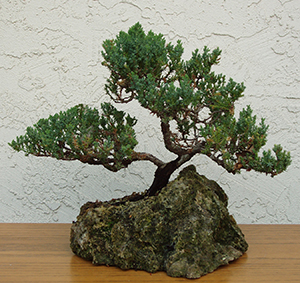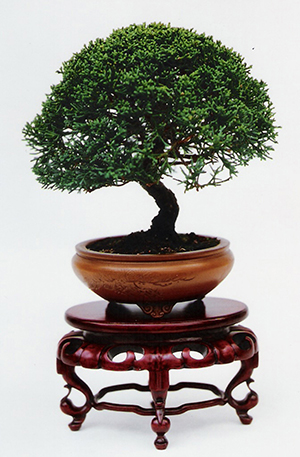Basics of Design
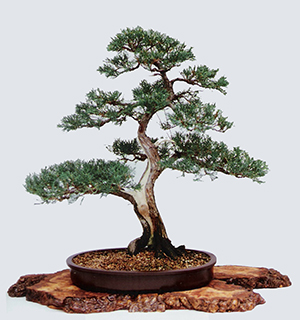
Informal Upright
by Lew Buller
There is only one formal upright in my collection, and that’s my bald cypress.
A formal upright requires a perfectly straight trunk and they are hard to come by. Consequently, most of my upright trees are of the informal style.

That’s OK; bonsai can be attractive, regardless of their style. Here’s my favorite. It’s a Virginiana juniper (Eastern Red Cedar).
The apex is directly over the root ball. There is a second variation considered acceptable by some, and that is to have a bend away from the trunk at the apex. Let the tree tell you what to do. Notice the branches are all on the outside of a bend. This maximizes the length of the branch and is easy for the eye to follow without losing track of the main design, which is to take your eye to the top of the tree.
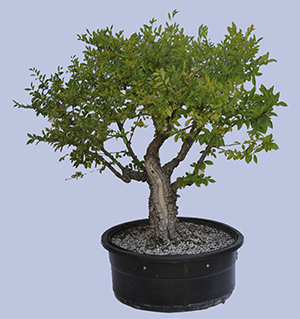
I was reminded again that bonsai are like children, you can’t keep them small no matter how nice that would be.
When a front branch (an eye poker) was removed, an entire strip of cambium died down the front. Like Bald Cypresses, the Cork Elm grows new cambium to cover the old dead wood. Here’s what it looks like today. Rather than call it an informal upright style, I may have to identify it as a broom style.
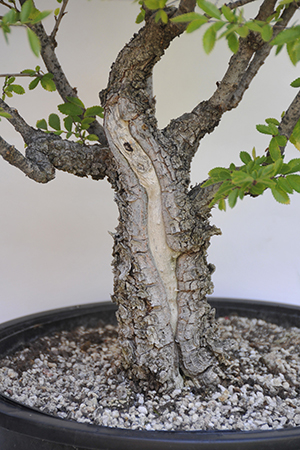
Here’s a better look at the dead cambium.
The live cambium appears about ready to join together again at the base. If it does, I will use lime sulfur on the shari to keep it from being covered over.
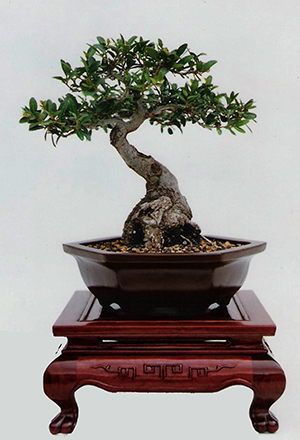
Admittedly the stand is a bit much for this delicate little Youpon Dwarf (nana) Holly. The tree deserves something not so burly and masculine, but rather more rounded and softer. This in spite of the very large rootage (nebari) prized by many bonsai enthusiasts. At 10” tall, it is among the smallest of my informal uprights.
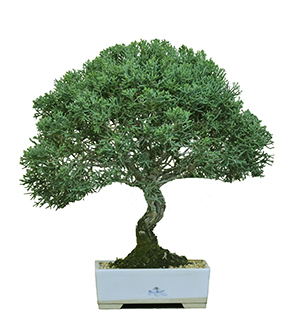
I like its common name better than its scientific name, Ilex vomitoria.
It tolerates San Diego’s alkaline soils better than other members of the Holly family. The usual non-alkaline mix was used in potting this tree, but the alkaline water in San Diego more than makes up for it.
Grafted kishu
Grafted kishu make very attractive small plants, and I have them in both slant style and informal upright style. Procumbens nana can also be made in this style.
The informal upright may be the most commonly found bonsai style. The requirements are simple: an apex over the root ball and interesting line leading to the apex.
Juniperus procumbens nana
Kishu scions are grafted onto several types of under stock, the two most used being the California juniper and the San Jose Juniper. My colleague in crime and I went to a wholesale nursery which must remain unnamed and explained that we needed quite a number of San Jose junipers for landscaping. We were allowed access to the growing grounds to pick out what we needed, and we did. We found 30-35 year old junipers with a spread of 5 feet or more. We ran our hands down the trunks and pulled out anything with a trunk too large to reach around with one hand. We stuffed as many as we could get into the truck, came home, unloaded them and went back a couple of days later.
Did the same thing, except that this time when we went to check out we were told not to come back again. We weren’t making the minimum purchase and we were cherry-picking the best of the trees.
Back in San Diego, the trees were made smaller by cutting the long branches back, always making sure to leave enough foliage to keep both branch and roots alive.
The following spring they were grafted with Kishu scions, but I took only one photo. It appears in “Raffia,” Bonsai Journal of the American Bonsai Society, 2012, Volume 46, Number 1, page 17.
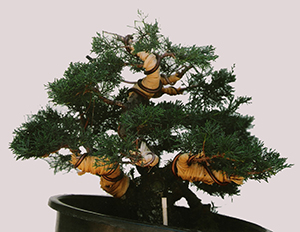
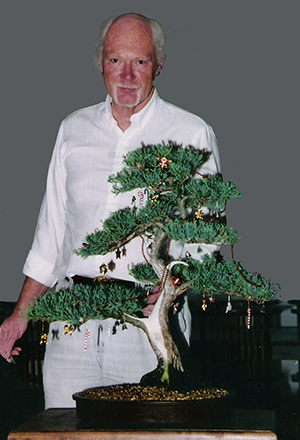
The formal photo is of my wife’s birthday present. We call it the Solitaire; she got that instead of a ring.
One year I decorated the Virginiana with miniature holiday decorations and sent a photo of just the tree to BCI, where it was published under the heading, “Yes, Virginiana, There is a Santa Claus.” This was a letter to a little girl that appeared on the New York Sun editorial page in 1897. (Bonsai Magazine, November/December 2001, Volume 40, Number 6, page 36.)
No matter what time of year you are reading this, Happy Holidays to you.

